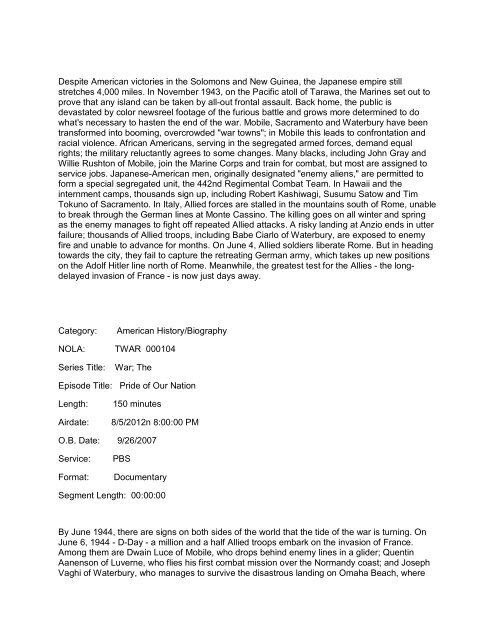Quarterly Program Topic Report July 1-15, 2012 Category ... - WYES
Quarterly Program Topic Report July 1-15, 2012 Category ... - WYES
Quarterly Program Topic Report July 1-15, 2012 Category ... - WYES
Create successful ePaper yourself
Turn your PDF publications into a flip-book with our unique Google optimized e-Paper software.
Despite American victories in the Solomons and New Guinea, the Japanese empire still<br />
stretches 4,000 miles. In November 1943, on the Pacific atoll of Tarawa, the Marines set out to<br />
prove that any island can be taken by all-out frontal assault. Back home, the public is<br />
devastated by color newsreel footage of the furious battle and grows more determined to do<br />
what's necessary to hasten the end of the war. Mobile, Sacramento and Waterbury have been<br />
transformed into booming, overcrowded "war towns"; in Mobile this leads to confrontation and<br />
racial violence. African Americans, serving in the segregated armed forces, demand equal<br />
rights; the military reluctantly agrees to some changes. Many blacks, including John Gray and<br />
Willie Rushton of Mobile, join the Marine Corps and train for combat, but most are assigned to<br />
service jobs. Japanese-American men, originally designated "enemy aliens," are permitted to<br />
form a special segregated unit, the 442nd Regimental Combat Team. In Hawaii and the<br />
internment camps, thousands sign up, including Robert Kashiwagi, Susumu Satow and Tim<br />
Tokuno of Sacramento. In Italy, Allied forces are stalled in the mountains south of Rome, unable<br />
to break through the German lines at Monte Cassino. The killing goes on all winter and spring<br />
as the enemy manages to fight off repeated Allied attacks. A risky landing at Anzio ends in utter<br />
failure; thousands of Allied troops, including Babe Ciarlo of Waterbury, are exposed to enemy<br />
fire and unable to advance for months. On June 4, Allied soldiers liberate Rome. But in heading<br />
towards the city, they fail to capture the retreating German army, which takes up new positions<br />
on the Adolf Hitler line north of Rome. Meanwhile, the greatest test for the Allies - the longdelayed<br />
invasion of France - is now just days away.<br />
<strong>Category</strong>:<br />
American History/Biography<br />
NOLA: TWAR 000104<br />
Series Title:<br />
War; The<br />
Episode Title: Pride of Our Nation<br />
Length:<br />
Airdate:<br />
<strong>15</strong>0 minutes<br />
8/5/<strong>2012</strong>n 8:00:00 PM<br />
O.B. Date: 9/26/2007<br />
Service:<br />
Format:<br />
PBS<br />
Documentary<br />
Segment Length: 00:00:00<br />
By June 1944, there are signs on both sides of the world that the tide of the war is turning. On<br />
June 6, 1944 - D-Day - a million and a half Allied troops embark on the invasion of France.<br />
Among them are Dwain Luce of Mobile, who drops behind enemy lines in a glider; Quentin<br />
Aanenson of Luverne, who flies his first combat mission over the Normandy coast; and Joseph<br />
Vaghi of Waterbury, who manages to survive the disastrous landing on Omaha Beach, where







